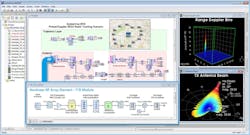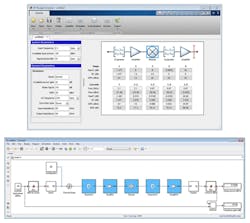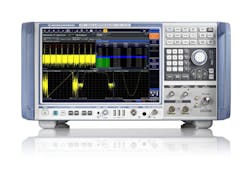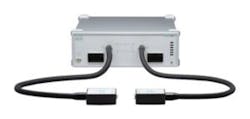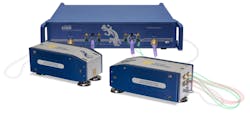Engineering functions including algorithm exploration and channel sounding are driving the emergence of 5G technology. Tools able to help drive 5G evolution include software, instruments, and measurement systems, as evidenced by exhibits at the International Microwave Symposium in May in San Francisco.
Mark Pierpoint, vice president and general manager, Internet and Infrastructure, Keysight Technologies, chose an IMS press conference to outline his view of technology’s evolution.
Pierpoint described a bimodal distribution of opportunities. Initiatives like SigFox, he said, focus on low bit-rate, low duty-cycle applications that can run 20 years on an AA cell. In contrast, many 5G prestandardization efforts promise better than 10-Gb/s continuous data rates with battery life undefined but perhaps measured in minutes.
Pierpoint cited several challenges on the horizon: simulation and characterization for IoT, WLAN evolution to 802.11ax, millimeter wave (mmWave) channel modeling, and radio access technology with regard to 5G rollout, 5G frequency selection, and waveform technology selection. However the evolution proceeds, he said, it would be a mistake to view mmWave technologies as simply a tenfold speedup of RF. Complications arise from issues such as path loss, which may be mitigated by high-gain directional antennas, and coexistence with existing mmWave applications.
On the IMS show floor, Keysight highlighted a variety of instruments and software, including the X-Series signal analyzers, the CX3300 Series device current waveform analyzers, and an E-band testbed solution that enables the generation and analysis of wide-bandwidth mmWave signals for 5G and other emerging communications applications.
As for software, Keysight highlighted the EEsof EDA SystemVue 2016 release (Figure 1), which includes a phased-array library and a 5G baseband verification library. The W1720EP Phased Array Beamforming Kit is a new add-on software simulation personality for the SystemVue 2016.08 design environment. The software enables researchers and system architects working on platforms using beamforming algorithms for 5G, satellite, NewSpace, radar, and EW applications to reduce interference and power consumption while increasing physical range.
Courtesy of Keysight Technologies
Active electronically scanned array (AESA) systems can range from 16 to 256 elements for 5G applications to hundreds of elements in satellite systems and many thousands of individual baseband and RF signal paths in military systems. Keysight said its EEsof EDA’s W1720EP kit addresses two key challenges with regard to AESA systems:
- Engineers can model highly parallel architectures across multiple simulation domains, allowing multiple teams to use the same tool and make architectural trade-offs.
- Engineers can model the signals as single beams or maintain access to the individual signals passing through the arrays, thereby enabling multifunction, 3D conformal arrays to be validated in higher-level system scenarios using active signaling between multiple transmitters and receivers.
By incorporating MathWorks’ MATLAB Script, SystemVue seamlessly integrates existing algorithms and extends array design tools to the RF and system design communities. This allows system modelers to explore the realistic performance of baseband and RF beamforming architectures to save cost and complexity and streamlines R&D design efficiency across disciplines.
Strengthening design support
MathWorks itself was at IMS, highlighting capabilities to strengthen design support for digitally assisted RF MIMO systems. Updates to RF Toolbox, SimRF, and the Antenna Toolbox in Release 2016a of its software will help engineers ramp-up on RF simulation, assist in performing a first-order RF budget analysis that is extendable with advanced models, and help integrate the results of RF design in system-level simulation. In Figure 2, the RF Budget Analyzer App simplifies the creation and analysis of RF architectures and automatically generates a block diagram model for simulation in Simulink.
Courtesy of MathWorks
Ken Karnofsky, senior strategist, signal processing, outlined some of the challenges and MathWorks’ approach to meeting them. Innovation drivers, he said, include ultrahigh throughput, massive connectivity for IoT, and device integration—all of which must be achieved in the face of accelerating product cycles. One result is a change in the need for particular engineering roles and skills.
Next-generation wireless designs, Karnofsky said, require at least seven different skills in the areas of system architecture design, DSP algorithm exploration, software development, digital-hardware design, mixed-signal design, RF design, and antenna design. MATLAB and Simulink, he said, span these areas from system architecture investigations through prototyping and product implementation. The software supports rapid and flexible algorithm exploration, design, and analysis while enabling unified simulation of digital, RF, and antenna elements.
Karnofsky outlined 5G requirements, including better than 20-Gb/s data rates, less than 10-ms latency, and LTE/WAN coexistence. Candidate technologies include massive MIMO and beamforming, active phased-array antennas, and new waveforms, including UFMC, FBMC, and GFDM. Candidate waveforms, Karnofsky said, can be defined and evaluated using MATLAB, with the goals of minimizing interference, assessing the impact of digital and hybrid beamforming techniques, and modeling and assessing the impact of antenna configurations. He described Ericsson’s use of MathWorks tools to develop an FPGA-based 5G testbed employing beamforming algorithms for multi-user MIMO, achieving 25-Gb/s data rates in a field trial.
mmWave transceiver
National Instruments highlighted a number of innovations at IMS, including advanced mmWave technology for channel sounding and 5G prototyping as well as advanced solutions for RFIC test from lab-based characterization systems to high-volume manufacturing test solutions using the NI Semiconductor Test System.
In addition, NI showcased a software-defined radio (SDR) for the mmWave spectrum. David Hall, principal product manager for RF test systems at NI, said the new NI mmWave transceiver system (Figure 3) can transmit and receive wide-bandwidth signals at a 2-GHz real-time bandwidth, covering the spectrum in the E-band, 71 to 76 GHz. Engineers and scientists have used SDRs in the spectrum below 6 GHz for years. However, Hall said, with companies investing in mmWave as a potential core technology for 5G, researchers now have a full-featured SDR platform to drive initiatives based on this technology.
Courtesy of National Instruments
The mmWave transceiver system includes new PXI Express modules that collectively function as an mmWave access point for a user device. Because of the transceiver’s flexibility, users can develop mmWave communication prototyping systems or perform channel measurements using the same system.
The mmWave baseband software delivers a complete mmWave physical layer including channel coding in LabVIEW virtual instrument source code to expedite system development while alleviating many of the system integration tasks. Researchers also can use the mmWave transceiver system baseband with the E-band mmWave heads or other third-party RF front ends to offer maximum flexibility for exploring other mmWave and microwave frequency bands.
According to Hall, 5G will undoubtedly include frequencies above 6 GHz, and the mmWave transceiver system will assist in understanding the propagation models of higher frequency signals and building real-world prototypes.
Hall said that Nokia, as a key participant in NI’s RF/Communications Lead User program, has been working with early versions of the mmWave transceiver system in its 5G research initiatives for more than a year. Tod Sizer, head of mobile radio research for Nokia Bell Labs, said in a press release, “NI’s mmWave transceiver system has been a key research platform for our mmWave research. The platform delivers the right combination of hardware and software necessary to expedite our research and has given us confidence that mmWave will indeed be a critical technology for 5G.” He added that at this year’s Brooklyn 5G Summit in April Nokia demonstrated a high-data-rate mmWave system using a phased array at 60 GHz using NI’s platform.
Rohde & Schwarz at IMS highlighted several products with applicability to 5G test, including its R&S TS-5GCS 5G channel sounding software together with an R&S FSW signal and spectrum analyzer (Figure 4) and an R&S SMW200A vector signal generator. The R&S SMW200A has a frequency range of up to 40 GHz and, in channel-sounding applications, is used as the sounding signal source. The R&S FSW operates as a receiver and can be employed with various frequencies and bandwidths. The R&S FSW85, for example, enables users to analyze sounding signals up to 85 GHz without an external mixer. Adding the R&S FSW-B2000 option extends the possible analysis bandwidth to 2 GHz.
Courtesy of Rohde & Schwarz
Vector network analyzers
Anritsu showcased its high-frequency test instruments that address the challenges associated with emerging microwave and mmWave technologies, including 5G. The company highlighted its VectorStar and ShockLine (Figure 5) vector network analyzer (VNA) families, both of which feature Anritsu’s patented nonlinear transmission line technology. The company demonstrated a measurement system featuring the VectorStar MS4640B VNA and the MG3710A RF signal generator that conducted modulated measurements, with the VNA configured with 200 MHz of instantaneous bandwidth. Anritsu exhibited the E-band option for its ShockLine MS46522B two-port VNA, which can make accurate measurements from 55 to 92 GHz in manufacturing environments.
Courtesy of Anritsu
Anritsu also highlighted a new eye-diagram option for VectorStar; the option can help SI engineers responsible for the design of high-speed data transmission requirements necessary for emerging systems such as 5G. The new Eye Diagram option updates the VectorStar display via a trace-based process rather than a conventional file-based method, eliminating the need to manually transfer .SnP files. Unlike other VNAs, there is no need to store the S-parameter performance in a file and then recall the file to observe the eye diagram. The company said the option improves measurement efficiency, analysis, and tuning of a data transmission signal path, allowing users to see the results of circuit changes in near real time.
Copper Mountain Technologies (CMT) highlighted two new VNAs and a reflectometer, and the company said it has teamed up with Farran Technology to develop a product for making mmWave S-parameter measurements. The result of CMT’s collaboration with Farran Technology is CobaltFx, (Figure 6) which, the companies said, provides lab-quality results in a compact and affordable solution. They called the system the first mmWave frequency extension solution built on a 9-GHz VNA. It is available in three dedicated waveguide bands: 50 to 75 GHz, 60 to 90 GHz, and 75 to 110 GHz.
Courtesy of Copper Mountain Technologies
The system is anchored by a 9-GHz VNA from CMT’s Cobalt Series. It features fast sweep speeds down to 10 μs per point and a dynamic range of up to 162 dB in a compact USB form factor. The C4209 works seamlessly and exclusively with Farran Technology’s mmWave FEV frequency extenders. Tom Scanlon, director of marketing and sales at Farran Technology, said the Cobalt Series’ high performance made possible the use of a 9-GHz VNA as opposed to the usual 20-GHz VNA.
The extenders are packaged in small and versatile enclosures that allow for flexible port arrangements with respect to waveguides. Waveguide ports are manufactured in accordance to the new IEEE 1785-2a standard and ensure industry-best alignment and repeatability of connection, allowing for long interval times between calibration.
Utilizing a lab-quality yet low-cost 9-GHz USB VNA and other innovations in the extension modules makes CobaltFx more compact and less expensive—about half that of existing solutions in the same frequency range, CMT said. The size and flexibility of the waveguide ports allow for significant improvements in portability and the lab-quality measurements, making it suitable for 5G applications.
CMT also announced that it has expanded the frequency range of its Compact VNA line to 6.5 and 8.5 GHz. The S5065 operates in the frequency range from 20 kHz to 6.5 GHz while the S5085 addresses the frequency range from 20 kHz to 8.5 GHz. These compact VNAs have a typical dynamic range of 138 dB at 1-Hz IFBW, can make measurements as fast as 70 μs per point, and are fully programmable.
“The rise of the Internet of Things (IoT) and 5G has RF engineers searching for test and measurement solutions that fit their changing needs. Smaller, lab-quality USB vector network analyzers help address that,” said Alex Goloschokin, CMT managing director, in a press release. “Increasing the frequency range of our Compact Series will allow even more engineers to make lab-quality measurements for the rapidly growing number of IoT devices they’re creating.”
Looking to next year
IMS 2016 concluded with a keynote from National Instruments’ president, CEO, and cofounder Dr. James Truchard about the importance of 5G, in which Dr. Truchard explained how a software-based approach will enable the explosion of wireless connectivity. He added that 5G will be a key technology of the IoT, offering the promise not only of high-speed data rates and low power, but also the low latency required for control applications.
“The concept of the platform will play a significant role in test and design in general,” he said, where millions of applications can run on one platform. “We at NI have hundreds of thousands of measurement apps all built around a common set of software and a common set of hardware.”
He proposed a hybrid approach with multiple models of computation to support quick prototyping and design. What’s needed, he explained, is a common platform for the entire design cycle—from algorithm engineering to end-device production test.
5G efforts are continuing. Since IMS, Keysight and National Applied Research Laboratories (NAR Labs), Taiwan, announced the signing of a memorandum of understanding to establish a strategic partnership on research and development of 5G communication technologies. Both parties are committed to working together on the 5G enabling technologies as well as prototype verification and evaluations with a goal of enhancing future Taiwan wireless communication innovations.
The partnership between Keysight and the National Chip Implementation Center of NAR Labs started with mmWave front-end circuit design technology and, the organizations said, will lead to the launch of next-generation high-speed broadband mmWave wireless communications experimental networks. The system will include a Keysight PSG vector signal generator, a 12-GS/s arbitrary waveform generator, and an Infiniium oscilloscope. Keysight’s SystemVue 5G Baseband Verification Library will accompany these hardware solutions. This advanced software library increases productivity for system architects and baseband physical-layer designers by providing trusted algorithmic-reference and signal processing capability for 5G technology research.
5G promises to be a key topic at IMS 2017, scheduled for June 4-9 in Honolulu. “5G is the next horizon for wireless connectivity and the catalyst to make the Internet of Things a universal reality, but the transition still presents a number of challenges for the microwave and RF industry to address,” said Dr. Wayne Shiroma, IMS 2017 general chair. “The sharing of knowledge and collaboration that IMS enables are the keys to bringing 5G, and technologies beyond it, to life.”
Chipmaker looks to 5G
Dedicated 5G chips are, of course, not in production as the standard remains in the R&D stage. Nevertheless, at IMS 2016 Qorvo highlighted a variety of chips and capabilities suggesting how cellular technology is evolving. Sumit Tomar, general manager of Qorvo’s Wireless Infrastructure Business Unit, said that with the advent of 5G techniques such as massive MIMO, it’s an exciting time for a semiconductor company providing RF solutions.
Tomar said he expects to see extensive activity both below and above 6 GHz as researchers evaluate trade-offs in range and data rates. He suggested that higher carrier frequencies may find use in extending indoor data-carrying capacities—in arenas, for example. He further said he doesn’t expect 4G to go away—rather, 5G functions will appear on top of 4G capabilities.
Tomar highlighted Qorvo’s new TQP92xx and TQP94xx families of power amplifiers (PAs) for small-cell base stations, which, he said, promise to improve connectivity, expand capacity, and minimize disruptions on LTE/LTE-Advanced networks. The devices target distributed antenna systems. Systems using these PAs can eliminate the need for linearization or digital predistortion correction, reducing system complexity. Qorvo’s eight new PAs cover 3GPP bands between 1.8 to 2.4 GHz and are pin-for-pin compatible.
Tomar said, “Multimode, multiband small-cell base stations pose significant RF challenges in terms of size, power-added efficiency, and co-existence between WLAN and cellular frequency bands. Qorvo has worked closely with customers to address these RF challenges to create a portfolio of PAs, LNAs, filters, and duplexers to enable carrier aggregation in small-cell base stations, and we’re pleased to add this new family of multistage PAs to that offering.”
Earl Lum, president of EJL Wireless Research, said in a press release, “While mobile operators continue to deploy outdoor macrocell sites to increase capacity, the wireless industry is transitioning to in-building wireless solutions. LTE/LTE-Advanced drives the need to extend wireless signal coverage indoors for corporate offices, hospitals, shopping malls, and other enterprise clients. Distributed antenna systems and carrier-grade OEM small-cell solutions like Ericsson Radio Dot, Huawei LampSite, Nokia Flexi Zone, and ZTE’s Qcell are key technologies that address the ever-growing in-building wireless coverage/capacity problem.”
Qorvo’s multistage PAs integrate matching in a low-cost surface-mount package to allow for compact system design. With linear performance at -47 dBc ACLR using a 20-MHz LTE signal, the TQP92xx product family provides 24-dBm average linear power, and the TQP94xx family offers 27-dBm average linear power.
For more information
About the Author

Rick Nelson
Contributing Editor
Rick is currently Contributing Technical Editor. He was Executive Editor for EE in 2011-2018. Previously he served on several publications, including EDN and Vision Systems Design, and has received awards for signed editorials from the American Society of Business Publication Editors. He began as a design engineer at General Electric and Litton Industries and earned a BSEE degree from Penn State.

